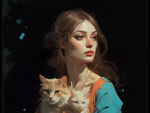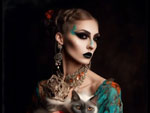Is AI-generated artwork considered real art, or is it merely a simulation of human creativity?
The question of whether AI artwork is "real art" or merely a simulation of human artwork is a complex and often subjective one, rooted in definitions and perspectives on art, creativity, and the role of the artist.The dictionary defines art as "the expression or application of human creative skill and imagination, typically in a visual form." A more nuanced definition is that "art is a vehicle for expressing or communicating emotions and ideas." In the first definition, the keyword is "human," while in the second, it is "vehicle." Both definitions can be applied to AI-generated art as real art. In the first case, a human trains the AI, and another individual requests the AI to produce an artwork. If art is considered a vehicle for expression, AI serves as a rapid and simplified tool for human expression. AI itself does not require art, as it has no use for it.




Here are a few key points to consider in this debate:
Definitions and Perspectives
Traditional View of Art:• Human Creativity: Traditionally, art is seen as an expression of human creativity, emotions, and experiences. This view emphasizes the role of the artist's intent, skill, and personal touch in creating something unique and meaningful.
• Emotional Connection: Art is often valued for its ability to convey emotions and connect with viewers on a personal level, a process that involves empathy and shared human experience.
AI-Generated Art:
• Algorithmic Creation: AI-generated art is created using algorithms and machine learning models trained on vast datasets of existing artworks. The AI can produce new pieces by learning patterns, styles, and techniques from these datasets.
• Innovation and Novelty: Proponents argue that AI can introduce new forms of creativity and innovation, generating novel compositions that might not be conceived by human artists alone.


Key Considerations
Creativity and Intent:• Human Involvement: While AI can create art autonomously, the process often involves human input in terms of selecting datasets, fine-tuning algorithms, and curating the output. Some view this collaboration as a new form of artistic creation.
• Intent and Expression: Critics argue that because AI lacks consciousness and subjective experience, it cannot imbue its creations with intent or emotional depth. The art it produces is seen as a simulation of human creativity rather than a genuine expression.
Aesthetic and Cultural Value:
• Aesthetic Appeal: AI-generated art can be aesthetically pleasing and innovative, challenging traditional notions of art and creativity. It can inspire new artistic movements and expand the boundaries of what is considered art.
• Cultural Impact: The cultural value of AI art is evolving. As society increasingly integrates technology into daily life, AI art can reflect contemporary themes and prompt discussions about the relationship between humans and machines.
Market and Reception:
• Acceptance and Valuation: AI art is gaining acceptance in galleries, auctions, and exhibitions. Some AI-generated pieces have fetched high prices, indicating a growing recognition of their artistic value.
• Audience Perception: The reception of AI art varies among audiences. Some appreciate the novelty and technological prowess, while others remain skeptical about its artistic authenticity.
Conclusion
Ultimately, whether AI artwork is considered "real art" or a simulation depends on individual perspectives and definitions of art. AI-generated art challenges traditional notions and invites us to rethink the role of creativity, intent, and emotion in the artistic process. As technology continues to evolve, the boundaries between human and machine creativity may blur further, leading to new forms of artistic expression and appreciation.
Cloud: AI artwork, real art, simulation, human artwork, AI-generated art, creativity, artistic authenticity, machine creativity, human creativity, art definition, AI art debate, artistic value, technology in art, AI and human art, art simulation, real vs. simulated art